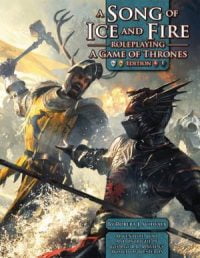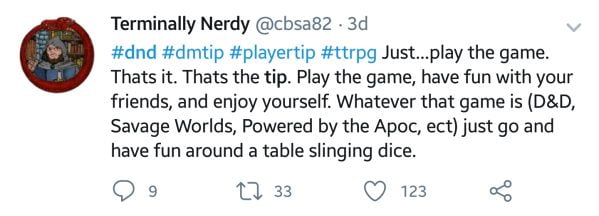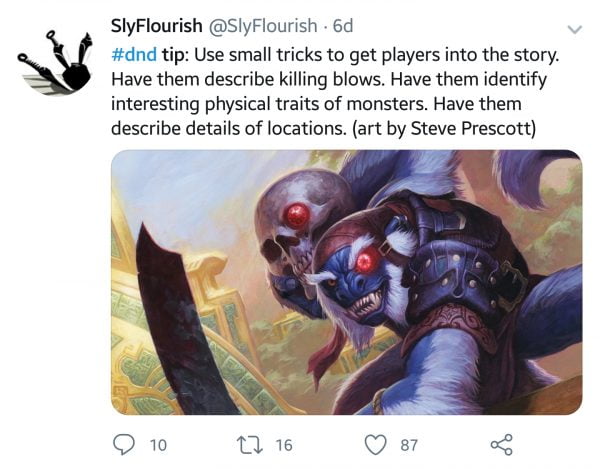One thing the table-top RPG (TTRPG) community is very good at is sharing titbits of knowledge, advice and wisdom on places like social media. The tips for new DMs can be for planning the next gaming session, how the DM should conduct the play at the gaming table, or advice on how players can contribute and enhance the night for everyone at the table.
Are you an inexperienced, beginner or new DM, do you need some tips and advice? Then read on.
I’ve collected my personal top 6 tips for new Dungeon Masters – though I’d say they’re just as applicable if you’ve been DM’ing for years. The tips shown here are from Twitter and I’ve paraphrased their wise words.

I found many DM tips online, some for world building, others for pepping up random encounters and some for making whole new races. Those Tweets I’ve put aside for later RPG articles. This article is just focusing on new Dungeon Masters.
Top tips for the new Dungeon Master
The tips below should help new DMs through core principles and contribute to off the shelf starter boxsets, as well as boosting their engagement with their players.

In this article the tips for new Dungeon Masters are RPG system agnostic, so it doesn’t matter if you playing the iconic Dungeons and Dragons, the current day settings of D20 Modern or Game of Thrones version of A Song of Ice and Fire.
If you prefer the term GM (Games Master), or Story-Teller, over Dungeon Master (DM), please substitute it in this article as you read on.
The tips are not necessarily aimed at home-brewed campaigns, but IMHO that would suggest a more experienced DM anyway. If you are a new DM and you are running your own adventure, or even campaign, then just give yourself a bit of extra time to plan ahead. (We may even do a blog post for DMs coming up with their own home-brewed content soon – stay tuned)
Tip #1: Focus on running a FUN game
Don’t take your DM role too seriously. You main job as a DM is to help your players have fun.
Misconception: The players are there to play the DMs game. This is wrong.
Reality: The players are there to play THEIR game of D&D (Pathfinder etc). You as a DM are there to HELP tell THEIR story. If the players don’t have fun because you’re too busy forcing them to play YOUR game, you won’t have a regular gaming group.

As @cbsa82 puts it:
Tip for new DM: Just play the game. Play the game, have fun with your friends and enjoy yourself. Whatever the game is, just go have fun around a table slinging dice.
Remember that the G in RPG stands for GAME.
Focus on being a great host.
Tip #2: Don’t over prepare. Improvise
Misconception: As a new Dungeon Master in D&D, you may feel like you need to plan everything to the letter, otherwise it’ll ruin the game.
Reality: Plan the basics – but plan to improvise.
Improvisation at the table may seem scary, but in reality its easier to improvise than it is to plan for everything.

Tip for new DM: Plan only what you need to plan. Force yourself to improvise at the table.
The hardest thing I find to improvise however, are names.
I like to keep a few lists of names nearby; names of towns and people mainly.
For example, if your players suddenly decide to quiz the innkeeper about what town is down the Eastern road and you haven’t prepared for it, whats better:
A) “Oh down the Eastern road… that’s… mmmm… Easter Town”
or
B) “Oh down the Eastern road, (glances to small note)… 30 miles out you’d come across the sea-side town of Hollowharbor.
Tip #3: You’re not your DM hero
Most of us participate in, watch or listen to other role playing games, as well as DM. Most of the Dungeon Masters in those games have been doing it for years, or even decades. Please don’t aspire to be them in your first few months or years.
As @snickelsox puts it, if you’re just starting out on your DM’ing path, worry less about how your DM hero does it, and more on encouraging fun that flows naturally at the table.

Tip #4: Let the players do *some* of the work

This tip for new DMs is by @SlyFlourish and is one I have used before but not nearly as much as I should have.
Tip for new DMs: Use small tricks to get players into the story. Have them describe killing blows.
Have them identify interesting physical traits of monsters.Have them describe details of locations.
Now I should explain why I’ve put a line through part of SlyFlourish’s tip. I agree with the part, but I believe that if you’re a new DM and your players aren’t accustomed to various monsters, they may give game breaking physical traits to monsters which you then have to juggle. As a DM you could either allow that trait to be applied, or undercut the players description. Either way I believe it’d add extra work where you don’t need it.
Example of players in control
So how can this work, well here’s a little example:
Beth (playing Kithdrey Axesmith): … my great axe deals … (rolls) … 8 points of damage, plus critical damage… so another (rolls) 4 points. 12 in total!
Alice (DM): Okay… your axe swings down and makes a solid impact with the ogres already bloody head. The blade cuts deep and you hear the crushing of bone and squelching of brains. As you remove the axe the limp body slumps to the floor with a reassuring thud.
Now there’s nothing wrong with that, it’s got some good sensory description in there and theres no confusion over what happened. But what if you let the player describe the kill every now and then.
Beth (playing Kithdrey Axesmith): … my great axe deals … (rolls) … 8 points of damage, plus critical damage… so another (rolls) 4 points. 12 in total!
Alice (DM): Okay thats a huge amount of damage. Describe to everyone what it’s like as you kill this ogre.
Beth: Yes! Okay first I swing the axe over my shoulder. When I notice the ogre drops its defense slightly I swing the axe violently over my head. It catches him on the side of his neck and sprays us all with thick warm blood.
Alice (DM): Brilliant and gruesome. As you retrieve your axe from his neck the lifeless body hits the floor with a reassuring thud.
Now this time the player has been allowed into the process of explaining exactly how the ogre is killed. Yes she rolled the dice which ultimately did enough damage to kill the ogre, but by getting Beth to describe what happened, she’s been integral to the kill.
Notice how the DM clarifies at the end that the body is lifeless, just in case anyone at the table thought the ogre was alive with Kithdrey’s axe in its neck.
Tip #4.1: Bonus Tip
Sneaky bonus tip for a new Dungeon Master here, that builds on the above.
When entering new locations, get the players to describe the finer details to non-essential objects or views. Here’s a quick example:
Alice (DM): As you pass the large bay window, your eyes are drawn through the clear glass panes to the vista beyond. Lavish gardens with neat flower beds radiate from the house. The lines of shrubs are neatly trimmed and look lush and healthy.
Again – perfectly acceptable. But how about this:
Alice (DM): As you pass the large bay window, your eyes are drawn through the clear glass planes to the immaculately kept sprawling gardens beyond. Describe to me what you see out there.
Charlie: I see several large ponds glisten in the summer sun. The rows of trees provide little shade, but are finely clipped and are obviously well taken care of. Several paths snake away from the house, one of which seems to lead to a hedge maze in the distance.
The DM has traded a small amount of control over the world to the player, but in return has received a great hook for a future adventure if she so wishes. The maze – what does it contain?
Obviously you can’t use this everytime a description is needed, but it can be refreshing to have the players contribute to the construction of the world.
Tip #5: You’ll make mistakes, don’t worry
One thing that many new DMs worry about is getting stuff wrong in front of their friends and family sat opposite them.
Maybe your cleric tried to turn a skeleton and you forgot that the nearby ghast should have granted it advantage (Read about D&D 5th Edition Advantage).
DMs see themselves as the story teller and guide, but what happens if the story goes wrong or the guide takes them the wrong way. What happens if you implement one of the rules wrong?

What happens? Well in truth, they probably won’t even notice.
@thegmstable says:
DM Tip of the Day: Don’t be afraid to get things wrong sometimes
Usually you’ll either get a rule wrong or a campaign setting wrong.
Some problems, such as accidentally handing out a super powerful weapon can be handled later or even become a plot point. Read my article on how to handle the mistake of handing powerful weapons.
Making judgement calls on unknown rules
If you get a rule wrong, or don’t know what rule needs to be applied, make a note of it for later. Then to deal with it, simply make a judgment call on whether what the player is asking for is trivial, easy, medium, hard, difficult or nigh on impossible to achieve.
For each level of difficult you think it is, make them do a D20 check with roughly the following DCs: Easy DC10. Medium DC15. Hard DC20. Difficult DC25. Nigh on Impossible DC30.
How about an example: a player falls down a pit, what is his chance of climbing out:
The pit sides are rough natural rock – make it easy: DC10
The pit sides are cut stone blocks – make it hard DC20
One thing to note though – try to be consistent. Players won’t mind you implementing a rule in a certain way, but if the next time it comes up you’ve changed it again, you’ll catch them on the back foot. The exception to this is at the start of a new session, hold your hands up and say you’ve read up on that specific rule and if everyones happy, you’ll now be playing it different.
If you do make a mistake, say give out a powerful weapon that you soon realise its TOO powerful, have NPCs covet the item. Read more about the DM handling overpowered items on my other article here.
Tip #6: Confused by player creation? Skip it

The @Grand_DM has some great advice here, which although is specific to the Dungeons and Dragons world, can easily be applied to Pathfinder and most other TTRPGs.
DM Tip: Need a last minute character? Dungeons and Dragons has per-generated character sheets of levels 1-10 on their website
Character creation, if you don’t like it, can appear as a massive swarm of attribute numbers, page turns and contradictory (or is it complimentary) factors.
If you just want to crack on with play, grab some pre-rolled characters. Read their background and their motives, then get playing.
Once you’re engrossed in a RPG system and fancy making your own character, read up on how to create one.
Top DM tips – TL;DR
Here’s a summary of the tips for new Dungeon Masters. A massive thank you to those I’ve quoted, it’s their advise on show here.
DM Tip #1: Focus on having fun. If you have fun it doesn’t matter about mistakes or blunders you’ll make
DM Tip #2: Over preparing is a thing – don’t do it. Learn to improvise – it relieves a lot of pressure.
DM Tip #3: Don’t try to replicate the behavior or results of your favourite dungeon master. They’ve got years of experience. Be yourself and continually learn new techniques.
DM Tip #4: Get your players to describe their kills or their actions. Say less of “okay, you did X”, more of “okay, describe how you did X”.
DM Tip #5: You’re going to make mistakes. Don’t draw attention to it, don’t flap, just adapt and move on.
DM Tip #6: If you’re eager to start, use pre-made characters for your players
Want to read more?
Now you’ve finished picking up some tips, how about browsing some gorgeous world building inspiration – or checking out the very best D&D miniatures to own.
Maybe you’re on the lookout for a new battle mat to improve your combat. Guess what – I’ve put together the six best battle mats to own too.
If you think you want to dive into Dungeons and Dragons with an official product – I can highly recommend these official Wizards of the Coast campaign books.